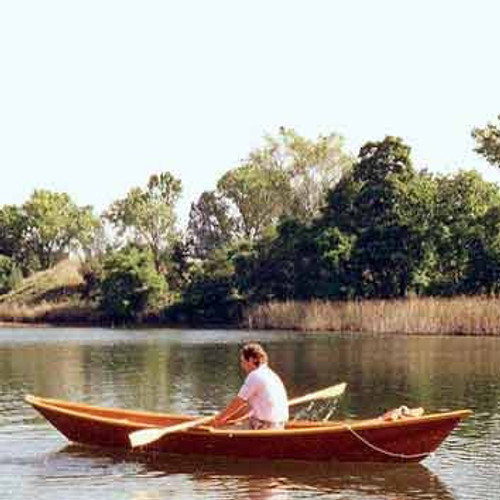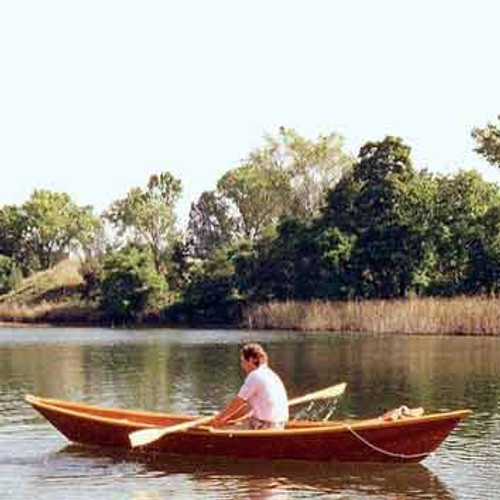Note: These plans consist of a booklet of 24 pages of text, drawings and photos on 8.5" x 11" pages plus a 20" x 24" drawing. The printed version is black and white. The PDF file for instant download has color photographs. To save $5 and postage costs choose the download option by ordering on this page. For printed plans, click HERE
***************
many versions from fishing platform to exercise machine
One of our most versatile boats, this simple dory has been built in many versions from fishing platform to exercise machine with "drop-in" sliding seat. Its light enough to car-top if you don't want to mess with a trailer, and can also be dragged up the beach above the tide line without a dolly. Camp-cruising and open-water versions will haul a pile of gear in watertight compartments and will float high even if swamped. Equipped with a swedish bailer the hull will also empty itself of water while rowing.
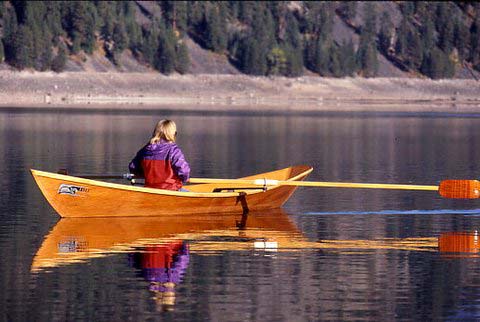
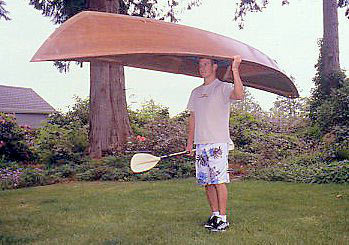
The flat bottom single chine dory hull form is stable enough to allow stretching and shifting position over the course of a long day on the water, and this hull will be fun in wave action that would disable a rowing shell. The hull is fast enough to make exercise rowing enjoyable, particularly with 9 foot sculls, and seaworthy enough to make crossings. With a removable thwart you can even sleep aboard, and this was the first of our camp-cruiser boats. Empty, the hull is quite responsive to the oars, and loaded for cruising the hull develops considerable additional stability to carry through small wind waves.
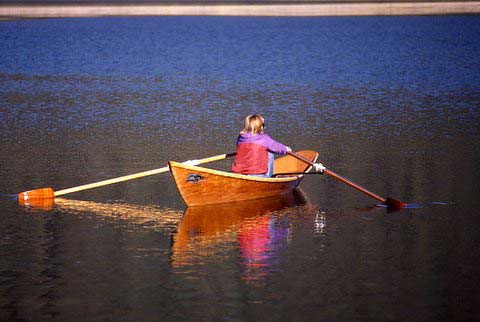
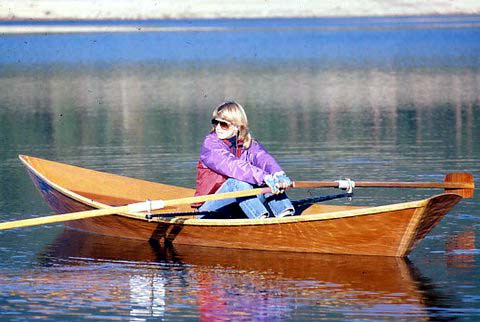
First published in Popular Science in 1987, an updated version was also featured in Workbench magazine in 1994. Easy to build of 8 foot sheet ply, the hull panels are held together with beads of epoxy and strips of glass tape. No scarfing and no difficult joinery required. Build it of quality hardwood ply and epoxy and it will last for years with minimal maintenance, or build an economy version of common lumberyard plywood. Compartments are structural, provide emergency flotation capability, and reinforce the clean rib-free interior to make building, finishing and maintenance easier. No critical fitting is required as bulkheads and compartment decks are easily attached and sealed with beads or fillets of thickened epoxy. Access hatches can be simple, easily installed plastic "screw-outs", or fancy hinged yacht type hatches. Trim wood can be lightweight softwood like fir or cedar, or more appealing hardwood like mahogany to match the hardwood hull plywood.
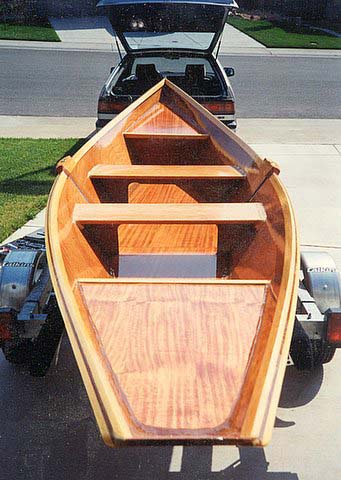
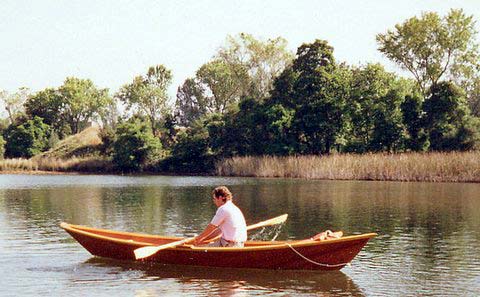
Below is a builders version of the Row Dory which is outfitted as a surf dory. Its a simplified cut-down hull about 14 feet long which can be paddled sitting or standing, or rowed. The hull can be made self-bailing by installing a flush fitting âSwedish bailerâ which siphons water with forward motion or drain scuppers with one way flaps can be cut into the hull sides of the footwell. Watertight compartments fill most of the hull to provide flotation when swamped in surf and also storage capacity for trips and camp cruising, and are accessed with small plastic ports which fit almost flush with deck or bulkhead to help prevent injury in surf and rough water. Tethered oars as short as four feet are most controllable launching and landing through moderate surf. The removable laminated oarlock recurve shown in these photos was custom built for flat water exercise rowing with 8 foot oars, and for full-body workouts a sliding seat drop-in unit can be installed and easily removed. The boat is just fast enough to provide enjoyable rowing on flat water and the hull can also be equipped with a short skeg to help prevent broaching sideways in waves. For hard use sacrificial rubbing strips can also be attached to the bottom and the hull has a tough slick graphite bottom which makes it easy to drag with a tether over gravel beaches and across cement launch ramps.
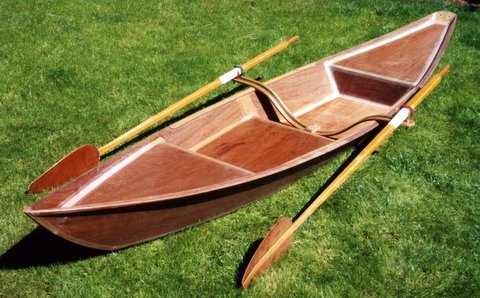
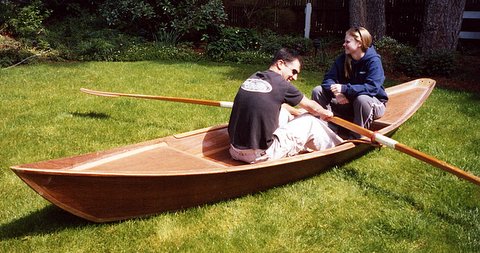
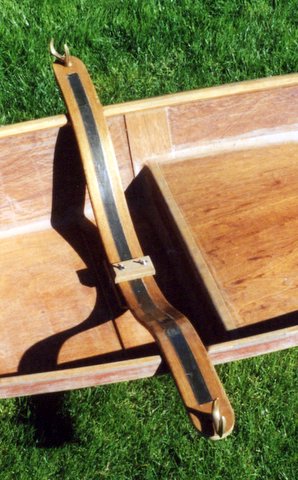
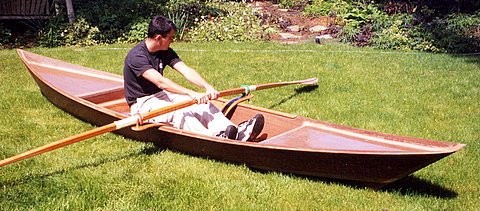
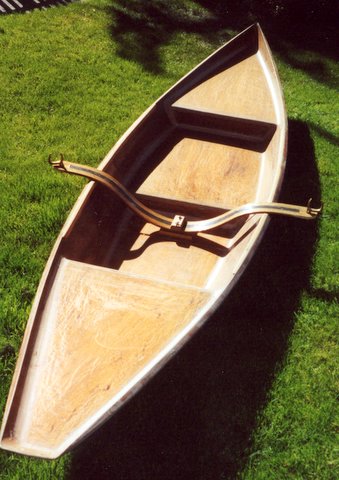
**********
Builder Comments and Photos
Paul:
Several months ago you and I emailed back and forth regarding seat placement in the rowing dory. As you can see I installed two seats, one on either side of the oarlocks. This arrangement allows me to row from the front or the back, with or without a passenger. Thanks a bunch for your clear plans and encouragement.
Murphy Dysart.
California



